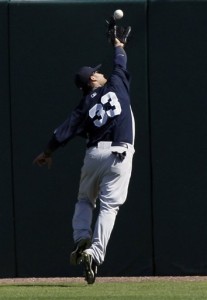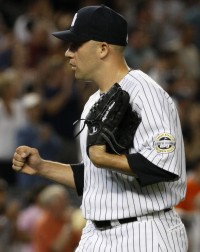Via Baseball America, the Yankees have signed righty hitting outfielder Reid Gorecki to a minor league deal, presumably with an invite to Spring Training. The 29-year-old from Queens is a career .268-.342-.428 hitter in the minors (.273-.342-.432 in Triple-A), and TotalZone says he’s been superb defensively in right and center over the last three years. He got his first taste of the big leagues with the Braves last season, hitting .200-.222-.200 in an irrelevant 27 plate appearance cameo.
I could have sworn Gorecki got Rule 5’d a few years ago, but I confused him with Ryan Goleski. Silly me. Once upon a time BA ranked him as the 11th best prospect in St. Louis’ system, confirming the TotalZone data by saying he was legit big league CF with speed, good instincts and a strong arm. Much like the Jon Weber signing, this is just a depth move. He’s actually got a slight reverse split for his career, so there’s really no point in even entertaining the idea of platooning him with Brett Gardner in left.
A few more minor league signings will trickle out over the next few weeks; probably a few arms, maybe another outfielder, another infielder, the usual.

 It’s sometimes hard to believe that Alfredo Aceves, the forgotten man out of Spring Training who didn’t arrive in the Bronx until May last year, finished with the fourth most wins on the Yankees. He always seemed to enter the game at exactly the right time, and he ended up with 10 wins and just one loss.
It’s sometimes hard to believe that Alfredo Aceves, the forgotten man out of Spring Training who didn’t arrive in the Bronx until May last year, finished with the fourth most wins on the Yankees. He always seemed to enter the game at exactly the right time, and he ended up with 10 wins and just one loss. 